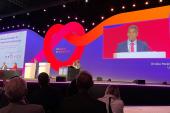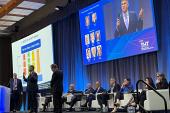Coincidental Nonischemic Cardiomyopathy Impacts Prognosis in CAD
The research raises questions about whether the finding on CMR affects the likelihood of benefit from revascularization.

Among patients with obstructive coronary disease, nonischemic or dual cardiomyopathy is commonly found on cardiac magnetic resonance (CMR) imaging—a combination that is tied to worse clinical outcomes, according to a retrospective study.
Compared with patients with ischemic cardiomyopathy, those with nonischemic or dual cardiomyopathy (both ischemic and nonischemic) had a significantly greater risk of a composite of all-cause death or heart failure hospitalization and of each of those outcomes individually, lead author Parag Bawaskar, MD, DM (University of Minnesota Medical School, Minneapolis), and colleagues report.
Bawaskar will present the findings as a poster at the upcoming American Heart Association 2023 Scientific Sessions in Philadelphia, PA, and they’ve been published online in Circulation.
This increased risk suggests that “in patients with obstructive CAD, coincidental nonischemic cardiomyopathy or dual cardiomyopathy may contribute to the lack of prognostic benefit from coronary revascularization,” they write.
And that, they say, opens avenues for additional studies, which “should investigate whether nonischemic or dual cardiomyopathy in patients with CAD influences outcomes specifically after coronary revascularization, and if so, whether the routine use of cardiovascular magnetic resonance imaging for the increased recognition of nonischemic or dual cardiomyopathy could improve the selection of patients for coronary revascularization, and long-term outcomes, compared to the standard of care.”
Commenting for TCTMD, Sunil Rao, MD (NYU Langone Medical Center, New York, NY), said the findings require independent validation. Still, they support “the idea that not all coronary disease is the same and in patients who have a reduced ejection fraction [EF] who also have that coronary disease, it’s probably worth investigating a little bit more whether or not that coronary disease is responsible for their reduced EF,” said Rao, immediate past president of the Society for Cardiovascular Angiography and Interventions. “Because once we know that information, it potentially could guide our therapies specifically as they relate to revascularization.”
Could CAD Be a Bystander?
Senior author Chetan Shenoy, MBBS (University of Minnesota Medical School), said the cause of cardiomyopathy is currently established using coronary angiography, with ischemic or nonischemic cardiomyopathy assumed in the presence or absence, respectively, of obstructive CAD.
“Pathology and small CMR studies have shown that this practice may not be accurate in some cases,” he explained to TCTMD via email. “This is because sometimes people have nonischemic cardiomyopathy with coincidental or bystander CAD, and conversely, they can have ischemic cardiomyopathy without CAD on angiography.”
Randomized trials of patients with obstructive CAD—including COURAGE, ISCHEMIA, BARI 2D, and REVIVED-BCIS2—mostly haven’t shown an improvement in prognosis with revascularization (with STICHES, the long-term extension of the STICH trial, being an exception). It’s possible, the investigators suggest, that the presence of nonischemic cardiomyopathy might be playing into these null findings since revascularization targets the coronary disease only.
It potentially could guide our therapies specifically as they relate to revascularization. Sunil Rao
To explore this issue, the investigators performed a retrospective study of consecutive patients with obstructive CAD on coronary angiography who underwent contrast-enhanced CMR imaging in four hospitals within the University of Minnesota M Health Fairview system between 2004 and 2020. The analysis included 3,023 patients (median age 66 years; 76% men). Most had a history of MI (59%) and of PCI (62%), with 20% having undergone CABG.
According to the CMR results, the median LVEF was 46%. Most patients (64.8%) had ischemic cardiomyopathy, 9.3% nonischemic cardiomyopathy, and 7.7% dual cardiomyopathy; the remaining 18.2% had no cardiomyopathy detected.
Before imaging, there was no clinical suspicion of anything other than ischemic cardiomyopathy in roughly half of the patients with nonischemic or dual cardiomyopathy.
Follow-up lasted a median of 4.8 years, and over that span, 36.9% of patients died from any cause or were hospitalized for heart failure. Compared with patients with ischemic cardiomyopathy, those who also have nonischemic or dual cardiomyopathy had a greater risk of that composite outcome after accounting for potential confounders (adjusted HR 1.23; 95% CI 1.06-1.43). They also had significantly higher risks of those individual outcomes, but not of CV death (adjusted HR 1.15; 95% CI 0.89-1.48).
A subgroup analysis of patients with an LVEF below 50% yielded similar findings, except that the difference in all-cause death became nonsignificant.
It’s not clear why patients with nonischemic or dual cardiomyopathy have worse outcomes, Shenoy said, but he speculated that “may be because these patients have more than one disease—CAD, nonischemic cardiomyopathy, and in those with dual cardiomyopathy, ischemic cardiomyopathy also, so two or three pathologies. They have adverse outcomes related to both CAD/atherosclerosis, and whichever nonischemic cardiomyopathy they have.”
Previous studies showing worse outcomes among patients with ischemic cardiomyopathy, he noted, have examined the impact of nonischemic cardiomyopathy defined by the absence of CAD (ie, only one pathology).
Rao, too, was unsure why outcomes favored patients with ischemic cardiomyopathy—a “very curious” finding that requires validation—in the current study.
“Maybe it has to do with the fact that we have therapies for ischemic cardiomyopathy and our therapies for nonischemic cardiomyopathy are not as robust,” he said. “It’s entirely possible that nonischemic cardiomyopathy patients are undertreated.”
Indeed, Bawaskar et al note, there are therapies specifically aimed at treating the causes of nonischemic cardiomyopathy that wouldn’t be used if patients were mistakenly diagnosed with ischemic cardiomyopathy.
More Circumspection Warranted
Shenoy said these findings suggest that “assuming the cause of cardiomyopathy based on the presence or absence of CAD can be flawed and it makes logical sense to determine the cause of cardiomyopathy—a heart muscle disease—using a technique that images the heart muscle—CMR.”
Yet it remains to be proven in an RCT that this strategy would improve patient outcomes compared with how it’s done now, he said, noting that one was just funded—the CROSS-HF trial at the University of Leeds.
Moreover, these findings “may have more-important implications when coronary revascularization is being considered for presumed ischemic LV dysfunction, since patients with nonischemic LV dysfunction would not be expected to benefit in the same manner as those with ischemic LV dysfunction,” Shenoy said.
Missing nonischemic or dual cardiomyopathy, or mistaking them for ischemic cardiomyopathy, is an issue that can influence the results of all trials of coronary revascularization, but the extent to which it contributed to the mostly null results of the RCTs is “difficult to know,” Shenoy said.
“REVIVED-BCIS2 is the least likely to have been affected by this issue because 70% of patients in the study got a CMR, and the investigators did exclude patients with nonischemic cardiomyopathy,” he pointed out. “However, they did not completely avoid the issue because 30% of the patients enrolled in the trial did not have a CMR.”
The issue may have partially influenced the findings of prior revascularization trials, although additional analyses—including a deeper look at the CMR data from REVIVED-BCIS2—would provide some insights, Rao indicated.
In the meantime, the current results won’t necessarily alter current management approaches but should spark additional research, he said, noting that proponents of CMR have long discussed increasing use of the modality to risk-stratify patients being considered for revascularization and to determine whether the coronary disease is incidental or related to the underlying disease process.
This study “certainly adds support to that particular paradigm,” but, Rao said, “I don’t know that we’re ready to switch completely over to making sure that every patient gets a preprocedure cardiac MRI just yet.”
The study, he added, “certainly starts pointing in the direction of being a little bit more circumspect when you start thinking about patients who have reduced ejection, and maybe additional investigations are warranted before a patient comes to the cath lab.”
Todd Neale is the Associate News Editor for TCTMD and a Senior Medical Journalist. He got his start in journalism at …
Read Full BioSources
Bawaskar P, Thomas N, Ismail K, et al. Non-ischemic or dual cardiomyopathy in patients with coronary artery disease. Circulation. 2023;Epub ahead of print.
Disclosures
- The study was supported by grants from the National Institutes of Health.
- Shenoy reports serving as a consultant for Medtronic and having served as a consultant for Lexeo Therapeutics.
- Bawaskar and Rao report no relevant conflicts of interest.





Comments